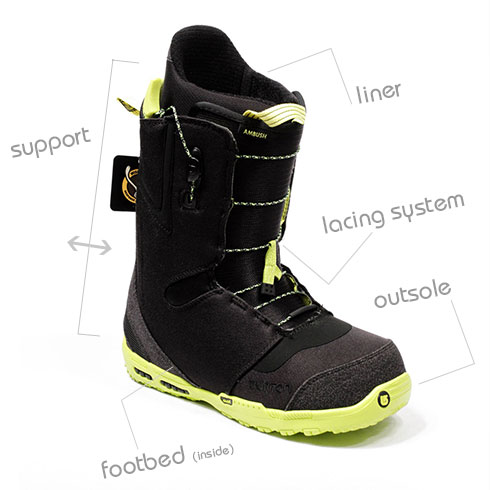Snowboard boots are the most important part of your setup. This can’t be stressed enough. If your feet aren’t happy neither are you. No point in buying a $700 snowboard and then going cheap on the boots. Always invest in boots first. Here are some factors to understand when looking at snowboard boots:
support
Snowboards vary greatly in the amount of support they provide. Support is also known as the stiffness or flex of the boot. While some people may tell you for you have to have stiff for all mountain and soft for park this is not necessarily true. A lot of it comes down to personal preference. Here is why you may want one or the other:
Soft: A more forgiving boot that won’t be as responsive. This can make them much more forgiving for beginners, people doing tricks, or if you simply don’t need your boots to turn on a dime.
Stiff: You don’t need to go old school hard boot to get a really responsive stiff boot. These boots will provide more support and be much more responsive when turning.
Some brands will offer removable flex control systems. You can ride without them and then as the boots break in and soften up they can be added back to increase the stiffness.
lacing system
Snowboards boots generally come with traditional laces, Boa, or quick pull system. Over the past several years most brands have moved towards the Boa or quick pull systems for the speed and ease of use.
Traditional Laces: Some people are originalists. These are generally inexpensive and easy to get replacement laces. They can be difficult to tie when tight and sometimes loosen unintentionally.
Boa: You can have either 1 or 2 dial systems. 1 dial is just as it sounds. One dial to control the entire boot. In a two dial system one controls the upper and the other the lower half of the boot. The 2 allow for a more customized fit but are more expensive. These are very easy to tighten or loosen with one hand even while wearing gloves. Downside is they add to the boots cost and generally need to get to a shop to replace the wire unless you carry a spare.
Quick Pull: Like the boa you can have either 1 or 2 pulls. Again with 2 one will control the upper and the other the lower half. These are easy to use even when wearing gloves and keep the boots snug all day. If a lace breaks you will either need to have another on you or take it to a shop. This rare and generally occurs if someone is resting their metal edge regularly on the lace.
footbed
Most footbeds are made from and EVA foam for the foundation. The density can vary for impact relief. Higher end footbeds will be injected with arch support, have airflow perforations, and anti-oder treatments added to them. Anti-order treatments keep bacteria from building up and the stink out of your boots. All these features can make for happy and fresh feet!
liner
The liner is the inner part of the snowboard boot. These are generally made from EVA that is similar to what running shoes are made out of. This provides stability, cushioning and insulation. Most liners are removable which can help them dry and air out after a day of riding. Some features you will find on different liners are:
Velcro or Lace Lock: This helps keep the liner snug around your leg. Its like an extra inner lace that will prevent heel lift and allow the outer shell to tighten better around the boot.
J-Bars: These are either built into the boot or can be added and removed. These wrap around the lower back end of the liner to help reduce heel lift.
Anti Microbial Coating: This helps keep the stink out. These reduce oder that can build up in a boot after a lot of days on the mountain.
Moldable: These will break in over time from the heat and pressure generated by your feet. They conform to your foot’s shape over time.
Heat Moldable: These liners are heated by an artificial heat source used by specialty shops. You then put the boots on and wear them for about 15-20 minutes. This will help the liners instantly form to your feet.
outsole
Many brands have started to add features to the outsole. They start with a basic molded EVA outsold and build from there. They can vary the thickness and density of the foam to help produce a different feel. Outsoles will often have air or gel built into the heels for impact absorption.
Higher end boots will even have features such as a Vibram outsold. This provides a certain grip and feel that people are used to in other styles of footwear. Boots with these style of outsoles will also be good for hiking in the backcountry.
